It looks like you're using an Ad Blocker.
Please white-list or disable AboveTopSecret.com in your ad-blocking tool.
Thank you.
Some features of ATS will be disabled while you continue to use an ad-blocker.
share:
reply to post by Kantzveldt
Well. Im stumped. I search for days and find nothing, you search an hour or less and find everything.
Love you.
Thanks a bunch mate.
If i get this correctly this t-shaped prayer staff originates from way way back. Representing moses staff, and moses was in egypt, so this could well be a spinn off of the tau-cross.
Well. Im stumped. I search for days and find nothing, you search an hour or less and find everything.
Love you.
Thanks a bunch mate.
If i get this correctly this t-shaped prayer staff originates from way way back. Representing moses staff, and moses was in egypt, so this could well be a spinn off of the tau-cross.
reply to post by jisujaaljo
You're welcome, i'm surprised it turned out to have such an interesting use, and yes this could go way back in conjunction with the sistrum. The musician/magicians probably also used the staff in connection with the driving out of demons, as well as the dancing and chanting.
You're welcome, i'm surprised it turned out to have such an interesting use, and yes this could go way back in conjunction with the sistrum. The musician/magicians probably also used the staff in connection with the driving out of demons, as well as the dancing and chanting.
reply to post by Kantzveldt
That could also mean that moses staff looked something like this instead of like a hook
If he existed that is
That could also mean that moses staff looked something like this instead of like a hook
If he existed that is
edit on 17-5-2012 by jisujaaljo because: (no reason given)
According to the legends a Saint Jared ascended to the Heavens some 1500 years or so ago and copied the idea from the Angels;
www.tadias.com...
Yared’s Zema is mythologized and sacralized to the extent that the composition is seen as a special gift from heaven. One version of the mythology is presented in Ethiopian book Sinkisar, a philosophical treatise, as follows: “When God sought praise on earth, he sent down birds from heaven in the images of angels so that they would teach Yared the music of the heavens in Ge’ez language. The birds sang melodious and heart warming songs to Yared. The birds noticed that Yared was immersed in their singing and then they voiced in Ge’ez:
“O Yared, you are the blessed and respected one; the womb that carried you is praised; the breasts that fed you the food of life are praised.”
Yared was then ascended to the heavens of the heaven, Jerusalem, where twenty-four scholars of the heaven conduct heavenly choruses. St Yared listened to the choruses by standing in the sacred chamber and he committed the music to memory. He then started to sing all the songs that he heard in the sacred chambers of the heaven to the gathered scholars. He then descended back to Aksum and at 9 a.m. (selestu saat) in the morning, inside the Aksum Zion church, he stood by the side of the Tabot (The Arc of the Covenant), raised his hands to heaven, and in high notes, which later labeled Mahlete Aryam (the highest), he sang the following:
“hale luya laab, hale luya lewold, hale luya wolemenfes qidus qidameha letsion semaye sarere wedagem arayo lemusse zekeme yegeber gibra ledebtera.”
With his song, he praised the natural world, the heavens and the Zion. He called the song Mahlete Aryam, which means the highest, referring to the seventh gates of heaven, where God resides. Yared, guided by the Holy Spirit, he saw the angels using drums, horns, sistra, Masinko and harp and tau-cross staff instruments to accompany their songs of praise to God, he decided to adopt these instruments to all the church music and chants.
www.tadias.com...
reply to post by Kantzveldt
Tau cross staff instrument. Haha. Awesome. Tau it is then. And the tau has a very long and old history.
Tau cross staff instrument. Haha. Awesome. Tau it is then. And the tau has a very long and old history.
Yes, my initial thoughts were that if it were a Tau cross that would ultimately trace back to Saint Anthony of Egypt, and from there back into even
more remote times.
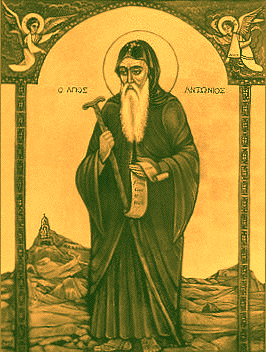
www.shsu.edu...

www.shsu.edu...
reply to post by Kantzveldt
Wow that is quite the read you're throwing up her for me to read.
Im about half throug the life of Anthony.
Its interesting but hard to read. Its the biblical old school kind of writing and since english aint my native language and the fact that i am ADHD That makes it so. Haha.
But il get back to you when im through.
The tau is one of the oldest religious symbols there is.
The tau comes from many things and one is the letter "t" and that letter is named tau after the minotaur in mythology.
If i wasnt so chicken i would probably start a thread about the whole thing, the conection between religious symbolism and letters and there origins.
/jimmy
Wow that is quite the read you're throwing up her for me to read.
Im about half throug the life of Anthony.
Its interesting but hard to read. Its the biblical old school kind of writing and since english aint my native language and the fact that i am ADHD That makes it so. Haha.
But il get back to you when im through.
The tau is one of the oldest religious symbols there is.
The tau comes from many things and one is the letter "t" and that letter is named tau after the minotaur in mythology.
If i wasnt so chicken i would probably start a thread about the whole thing, the conection between religious symbolism and letters and there origins.
/jimmy
Yes sorry about the full ecclesiastical history... ....you'd be surprised though how much has been made of the Feast Day of Saint Anthony on the
17th of January.
www.oodegr.com...
The basic reason is that there was a Saint Paul of Lower Egypt whose Feast Day is the 16th of January, who lived at the time of Anthony of Upper Egypt and eventually they met up, this is related to the union of the two lands, upper and lower Egypt, the red and white crowns of the Black land, Egypt.
The Tau cross of Saint Anthony then refers to this binding of the Two Lands iconography;
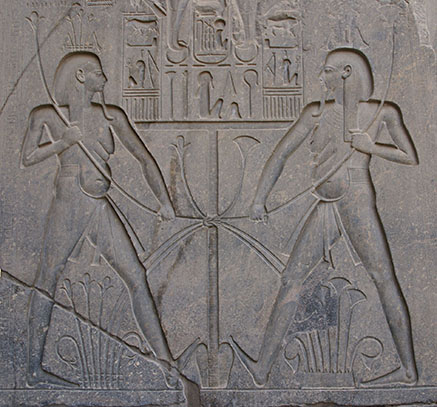
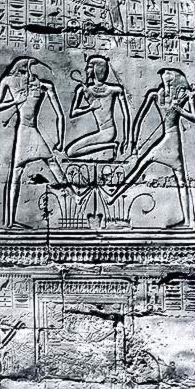
Epiphany then, in the orthodox church takes place over the 18th to 19th of January, the Festival seen celebrated in the Ethiopian pictures
www.oodegr.com...
The basic reason is that there was a Saint Paul of Lower Egypt whose Feast Day is the 16th of January, who lived at the time of Anthony of Upper Egypt and eventually they met up, this is related to the union of the two lands, upper and lower Egypt, the red and white crowns of the Black land, Egypt.
The Tau cross of Saint Anthony then refers to this binding of the Two Lands iconography;


Epiphany then, in the orthodox church takes place over the 18th to 19th of January, the Festival seen celebrated in the Ethiopian pictures
edit
on 18-5-2012 by Kantzveldt because: typo
edit on 18-5-2012 by Kantzveldt because: Add images
reply to post by Kantzveldt
The tau can be traced back to the summerian god dumuzi wich translates to "real sun" the akkadian version of the same god was tammuz.
The story about dumuzi/tammus bears strong resemblence to the osiris myth.
So much so that im willing to bet that osiris is the egyptian version of dumuzi/tammuz.
Dumuzi represented growth and rebirth. And he was worshiped a LOT during the hot and dry season so that things should start to grow again.
The tau can be traced back to the summerian god dumuzi wich translates to "real sun" the akkadian version of the same god was tammuz.
The story about dumuzi/tammus bears strong resemblence to the osiris myth.
So much so that im willing to bet that osiris is the egyptian version of dumuzi/tammuz.
Dumuzi represented growth and rebirth. And he was worshiped a LOT during the hot and dry season so that things should start to grow again.
Originally posted by dawnprince
Try the Antiques Roadshow .
This is not an antiques forum.
If you are only interested in monetary gains then I have no time for you .
If however you are willing to donate your finds to relevant collections, then good luck to you
edit on 16-5-2012 by dawnprince because: (no reason given)
You, at the very least, need to work on your people skills. I just don't see how you could not have realized how condescending you came across with your response. We don't need people like you on the forums to be quite honest. To the OP...It looks similar to medieval artwork that I have seen, at least in style. The fact that it is wooden also makes me think it is rather old, but it is hard to say, since it could be a modern-day re-creation.
That particular style may be from a different period, and since I am no expert I cannot be certain on the medieval origin, but that was my first thought. Isn't it strange how the poster I quoted didn't have time for you, yet wasted all our time by creating a post just to say that? lol. fail. You should sell it and then rub it in his face just to spite him. Good luck in finding the origin of the piece of artwork. I am interested to know if the suggestion for the picture analysis via the Chrome plugin yields any similar artwork. Keep us posted.
reply to post by JiggyPotamus
Hi
Aww dont go to hard on the poor sod
He must have had a rough day or something)
As for the icon, im kind of stuck. Thanks to one detective poster earlier in the thread the chrome thing wasent needed
Here's what i know so far. Its Ethiopian and they have done these kind of icons for a long long time. And im guessing this one is in the middle of that time somewhere.
And that would put it in the middle ages somewhere.
Thanks for stopping by friend
/jimmy
Hi
Aww dont go to hard on the poor sod
He must have had a rough day or something)
As for the icon, im kind of stuck. Thanks to one detective poster earlier in the thread the chrome thing wasent needed
Here's what i know so far. Its Ethiopian and they have done these kind of icons for a long long time. And im guessing this one is in the middle of that time somewhere.
And that would put it in the middle ages somewhere.
Thanks for stopping by friend
/jimmy
reply to post by jisujaaljo
Things are a little more complicated than that i feel, in terms of usage as a formal symbol. Dumuzi was a God of nature and at an early date associate with plants and trees, these could take the form of a rudimentary cross;

Tammuz also then had the cross associated with him in many forms, however up until the Classical period i'm not aware of any that could be described as a Tau cross. There is the Hittite 'Flower of Life' symbol which shows correspondance to the Dumuzi symbolism, that also quite closely resembles the Ankh cross in style and the manner in which it is offered.
www.atamanhotel.com...
Osiris from the 5th Dynasty onwards does have aspects relating to this Near Eastern Deity, but again with differances and complications.
That being said, there is this;
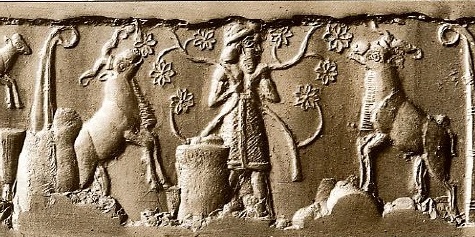
An early seal impression of Dumuzi circa 3,200 Bc, or from when the the Lands of Egypt were first bound together. The symbols to the left and right are of Inanna, later Venus/Ishtar, in conjunction with the mountains of the Eastern and Western horizons, Dumuzi in a sense binds these, binds the principle of setting with that of rising, binds the principle of death with life, he had a dualistic capacity and spent half the year in the underworld. Consider also the form of the bovine horns.
What was bound in Egypt was the North-South axis of the Kingdom, again though with dualistic premise in the form of Horus and Set. The cult of Osiris would be concerned though, after the Near Eastern model, with the transition through the Eastern/Western horizons, his Wagy Festival was on the 18th day of the first month.
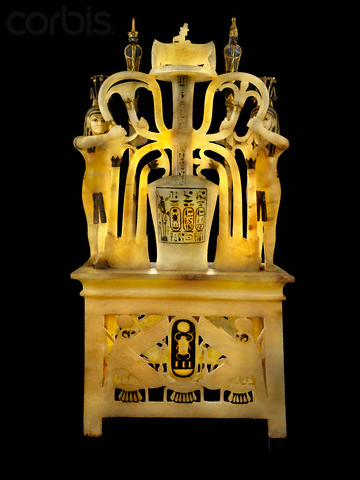
An interesting tale then, from Ethiopia to Sweden, and the syncretism of Western Greek thought meeting Eastern Buddhism...
Things are a little more complicated than that i feel, in terms of usage as a formal symbol. Dumuzi was a God of nature and at an early date associate with plants and trees, these could take the form of a rudimentary cross;

Tammuz also then had the cross associated with him in many forms, however up until the Classical period i'm not aware of any that could be described as a Tau cross. There is the Hittite 'Flower of Life' symbol which shows correspondance to the Dumuzi symbolism, that also quite closely resembles the Ankh cross in style and the manner in which it is offered.
www.atamanhotel.com...
Osiris from the 5th Dynasty onwards does have aspects relating to this Near Eastern Deity, but again with differances and complications.
That being said, there is this;

An early seal impression of Dumuzi circa 3,200 Bc, or from when the the Lands of Egypt were first bound together. The symbols to the left and right are of Inanna, later Venus/Ishtar, in conjunction with the mountains of the Eastern and Western horizons, Dumuzi in a sense binds these, binds the principle of setting with that of rising, binds the principle of death with life, he had a dualistic capacity and spent half the year in the underworld. Consider also the form of the bovine horns.
What was bound in Egypt was the North-South axis of the Kingdom, again though with dualistic premise in the form of Horus and Set. The cult of Osiris would be concerned though, after the Near Eastern model, with the transition through the Eastern/Western horizons, his Wagy Festival was on the 18th day of the first month.

An interesting tale then, from Ethiopia to Sweden, and the syncretism of Western Greek thought meeting Eastern Buddhism...
edit on 19-5-2012 by Kantzveldt because: typo
edit on 19-5-2012 by Kantzveldt because: (no reason given)
edit
on 19-5-2012 by Kantzveldt because: note
new topics
-
Russian intelligence officer: explosions at defense factories in the USA and Wales may be sabotage
Weaponry: 2 hours ago -
African "Newcomers" Tell NYC They Don't Like the Free Food or Shelter They've Been Given
Social Issues and Civil Unrest: 3 hours ago -
Russia Flooding
Other Current Events: 4 hours ago -
MULTIPLE SKYMASTER MESSAGES GOING OUT
World War Three: 5 hours ago -
Two Serious Crimes Committed by President JOE BIDEN that are Easy to Impeach Him For.
US Political Madness: 6 hours ago -
911 emergency lines are DOWN across multiple states
Breaking Alternative News: 6 hours ago -
Former NYT Reporter Attacks Scientists For Misleading Him Over COVID Lab-Leak Theory
Education and Media: 8 hours ago -
Why did Phizer team with nanobot maker
Medical Issues & Conspiracies: 8 hours ago -
Pro Hamas protesters at Columbia claim hit with chemical spray
World War Three: 8 hours ago -
Elites disapearing
Political Conspiracies: 11 hours ago
top topics
-
Go Woke, Go Broke--Forbes Confirms Disney Has Lost Money On Star Wars
Movies: 13 hours ago, 13 flags -
Pro Hamas protesters at Columbia claim hit with chemical spray
World War Three: 8 hours ago, 11 flags -
Elites disapearing
Political Conspiracies: 11 hours ago, 9 flags -
Freddie Mercury
Paranormal Studies: 13 hours ago, 7 flags -
Nirvana - Immigrant Song
Music: 17 hours ago, 5 flags -
A Personal Cigar UFO/UAP Video footage I have held onto and will release it here and now.
Aliens and UFOs: 11 hours ago, 5 flags -
African "Newcomers" Tell NYC They Don't Like the Free Food or Shelter They've Been Given
Social Issues and Civil Unrest: 3 hours ago, 5 flags -
Two Serious Crimes Committed by President JOE BIDEN that are Easy to Impeach Him For.
US Political Madness: 6 hours ago, 5 flags -
911 emergency lines are DOWN across multiple states
Breaking Alternative News: 6 hours ago, 4 flags -
Former NYT Reporter Attacks Scientists For Misleading Him Over COVID Lab-Leak Theory
Education and Media: 8 hours ago, 4 flags
active topics
-
Russian intelligence officer: explosions at defense factories in the USA and Wales may be sabotage
Weaponry • 23 • : Lazy88 -
MULTIPLE SKYMASTER MESSAGES GOING OUT
World War Three • 14 • : RussianTroll -
African "Newcomers" Tell NYC They Don't Like the Free Food or Shelter They've Been Given
Social Issues and Civil Unrest • 5 • : sine.nomine -
Russia Flooding
Other Current Events • 2 • : Hakaiju -
God is watching.
Politicians & People • 27 • : PrivateAngel -
Mood Music Part VI
Music • 3051 • : BrucellaOrchitis -
I Guess Cloud Seeding Works
Fragile Earth • 21 • : BrucellaOrchitis -
Elites disapearing
Political Conspiracies • 20 • : HerbertWest -
What Time is it on the Moon ?
Space Exploration • 50 • : wildespace2 -
Why did Phizer team with nanobot maker
Medical Issues & Conspiracies • 6 • : annonentity
